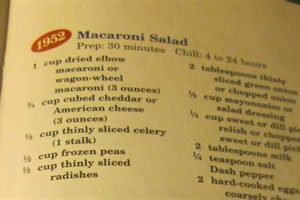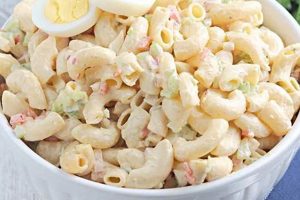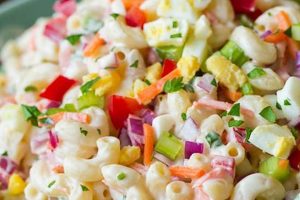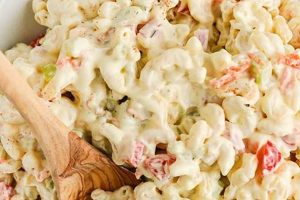Macaroni salad, prepared from scratch in one’s own kitchen, typically involves cooked elbow macaroni combined with a variety of other ingredients. These often include mayonnaise, vegetables such as celery and onions, and seasonings like mustard, vinegar, and salt. Numerous variations exist, incorporating ingredients like hard-boiled eggs, cheeses, meats, or relish, reflecting diverse culinary preferences.
Crafting this dish personally offers significant advantages. Control over ingredient selection allows for customization based on dietary needs and taste preferences, leading to a fresher, potentially healthier, and more flavorful outcome than store-bought alternatives. This also provides an opportunity to explore creative variations and personalize the recipe, transforming a simple side dish into a culinary expression. The practice of making macaroni salad at home connects to a long history of home cooking and communal meals, often associated with picnics, potlucks, and family gatherings.
This discussion will explore the essential elements of crafting exceptional macaroni salad, offering guidance on ingredient selection, preparation techniques, variations, and tips for achieving optimal flavor and texture.
Tips for Exceptional Macaroni Salad
Achieving a perfect macaroni salad involves attention to detail throughout the preparation process. The following tips provide guidance on enhancing flavor, texture, and overall quality.
Tip 1: Cook Macaroni Properly: Overcooked macaroni results in a mushy salad. Cook pasta al dente, slightly firm to the bite, as it will soften further as it absorbs the dressing.
Tip 2: Chill Ingredients Thoroughly: Using chilled ingredients, especially the macaroni, prevents the mayonnaise from becoming overly thin and helps maintain the salad’s texture.
Tip 3: Balance Flavors Carefully: The interplay of sweet, tangy, and savory elements is crucial. Adjust the amounts of vinegar, mustard, and other seasonings to achieve the desired balance.
Tip 4: Enhance Texture with Variety: Consider adding ingredients that offer textural contrast, such as chopped celery, bell peppers, or shredded carrots.
Tip 5: Choose High-Quality Mayonnaise: The mayonnaise base significantly impacts the final flavor. Opting for a high-quality mayonnaise enhances the overall richness and creaminess.
Tip 6: Season in Stages: Add seasonings gradually, tasting and adjusting as needed, to prevent over-seasoning and ensure balanced flavor development.
Tip 7: Allow Flavors to Meld: Refrigerate the salad for at least an hour before serving. This allows the flavors to blend and the salad to chill completely.
By following these guidelines, one can create a macaroni salad that is both flavorful and visually appealing, enhancing any meal or gathering.
These tips provide a foundation for crafting exceptional macaroni salad. Experimentation with various ingredients and techniques further personalizes the recipe and elevates the culinary experience.
1. Pasta Selection
Pasta selection significantly influences the final character of homemade macaroni salad. The type of pasta affects not only the visual appeal but also the texture and how well it holds the dressing. Choosing the right pasta is crucial for a successful and satisfying salad.
- Classic Elbow Macaroni:
Elbow macaroni remains the quintessential choice for this dish. Its curved shape readily captures the dressing, ensuring each bite is flavorful. This classic selection offers a familiar and comforting experience, aligning with traditional expectations.
- Small Shell Pasta:
Small shells, such as ditalini or small shells, offer a pleasing alternative. Their crevices and folds hold the dressing effectively, creating a rich, flavorful experience. They add visual interest and can enhance the perception of a creamier texture.
- Rotini and Fusilli:
Spiral-shaped pasta like rotini or fusilli introduce a dynamic element. These shapes create textural complexity and distribute the dressing evenly. Their playful appearance can add a modern touch to a classic dish.
- Alternative Small Pasta Shapes:
Other small pasta shapes, such as orzo or farfalle (bowtie), can be incorporated for unique variations. Orzo offers a rice-like texture, while farfalle contributes a distinctive visual element. These choices allow for creative exploration and personalized adaptations.
The selected pasta shape contributes significantly to the overall enjoyment of homemade macaroni salad. While elbow macaroni provides a traditional experience, exploring alternative shapes offers opportunities for customization and textural variation, enhancing both the visual appeal and the culinary experience.
2. Dressing Choices
Dressing choices profoundly influence the flavor profile and overall quality of homemade macaroni salad. The dressing acts as the unifying element, binding the ingredients and imparting the dominant taste. A well-chosen dressing elevates the dish beyond a simple combination of ingredients, transforming it into a cohesive and flavorful experience. The interplay of creamy, tangy, and savory elements within the dressing determines the final character of the salad. For instance, a classic mayonnaise-based dressing provides a rich, creamy texture, while a vinaigrette-based dressing offers a lighter, brighter alternative. The selection must complement the other ingredients and cater to individual preferences.
Understanding the impact of dressing choices empowers culinary creativity. A traditional mayonnaise-based dressing, enhanced with mustard, vinegar, and seasonings, provides a familiar foundation. However, variations incorporating buttermilk, sour cream, or yogurt offer lighter, tangier profiles. Incorporating fresh herbs, spices, or flavored oils further expands the possibilities, allowing for personalized flavor combinations. The ratio of ingredients within the dressing also plays a crucial role; adjusting the amount of vinegar or mustard can shift the balance between sweet and tangy, catering to specific tastes. Consider a dressing featuring a blend of mayonnaise, Dijon mustard, apple cider vinegar, and celery seed for a balanced flavor profile. Conversely, a dressing emphasizing olive oil, lemon juice, and fresh dill creates a Mediterranean-inspired variation.
Careful consideration of dressing choices is essential for crafting exceptional macaroni salad. The dressing serves not merely as a binder but as the defining element of the dish. A thoughtful approach to dressing selection, considering the balance of flavors and the interplay of ingredients, allows for customized creations that cater to individual preferences and elevate the culinary experience. Experimentation and adaptation of existing recipes, based on an understanding of these principles, unlock a world of flavor possibilities, transforming a simple side dish into a culinary masterpiece.
3. Vegetable Combinations
Vegetable combinations play a pivotal role in homemade macaroni salad recipes, contributing significantly to texture, flavor, and nutritional value. The choice of vegetables influences not only the sensory experience but also the overall balance and appeal of the dish. A thoughtful approach to vegetable selection elevates macaroni salad from a simple side to a more complex and satisfying culinary creation. The interplay of textures, ranging from crisp to tender, adds depth and interest. Similarly, the variety of flavors, from sweet to savory, creates a balanced and nuanced profile. Furthermore, incorporating a diverse range of vegetables enhances the nutritional content of the salad, contributing vitamins, minerals, and fiber.
Consider the classic combination of celery and onion, which provides a familiar foundation. Celery offers a crisp, refreshing counterpoint to the creamy dressing, while onion adds a subtle pungent note. Alternatively, incorporating bell peppers introduces both sweetness and crunch, while chopped carrots contribute sweetness and a vibrant color. Cucumbers provide a refreshing, cooling element, while chopped pickles offer a tangy, acidic contrast. These examples illustrate the diverse possibilities available when selecting vegetable combinations. Adapting these combinations to personal preferences or dietary needs allows for a personalized culinary experience. For instance, substituting red onion for yellow onion offers a milder flavor, while incorporating chopped fresh herbs, such as parsley or dill, adds a fresh, aromatic dimension.
Strategic vegetable selection enhances the overall quality and appeal of homemade macaroni salad. Balancing textures and flavors creates a harmonious and satisfying dish. Understanding the interplay of different vegetables empowers culinary creativity, allowing for endless variations tailored to individual tastes and dietary requirements. The considered incorporation of vegetables transforms macaroni salad into a versatile and nutritious dish, suitable for various occasions.
4. Protein Additions
Protein additions represent a significant opportunity to enhance both the nutritional value and the flavor profile of homemade macaroni salad. Incorporating protein transforms the dish from a side item into a more substantial and satisfying meal component. The choice of protein significantly influences the overall character of the salad, offering a wide range of flavor and texture possibilities.
- Hard-Boiled Eggs:
A classic addition, hard-boiled eggs contribute a creamy texture and a subtly savory flavor. Their readily available nature and ease of preparation make them a convenient and popular choice. The yolks also add a richness that complements the creamy dressing. Dicing the eggs ensures even distribution throughout the salad.
- Cured Meats:
Cured meats, such as diced ham, salami, or bacon, introduce a salty, savory element. These options offer diverse flavor profiles, ranging from smoky bacon to the more nuanced flavors of cured ham or salami. The choice of cured meat can significantly influence the overall taste of the salad, adding depth and complexity.
- Canned Tuna or Salmon:
Canned tuna or salmon offer convenient and affordable protein options. These choices provide a distinct flavor profile and contribute healthy fats. Draining the liquid thoroughly before adding to the salad is essential to prevent a watery consistency. Flaking the fish ensures even distribution and integration with the other ingredients.
- Shredded or Cubed Cheese:
Cheese, whether shredded cheddar, cubed Swiss, or crumbled feta, introduces a savory dimension and textural variation. The choice of cheese influences the overall flavor profile, from the sharpness of cheddar to the salty tang of feta. Cheese also contributes to the creaminess of the salad and complements the other ingredients.
The strategic inclusion of protein elevates homemade macaroni salad, expanding its versatility and nutritional value. Careful consideration of protein choices, considering both flavor and texture, allows for customized creations tailored to individual preferences. From classic additions like hard-boiled eggs to more adventurous choices like cured meats or cheeses, protein additions transform macaroni salad into a more substantial and satisfying component of any meal.
5. Seasoning Balance
Seasoning balance is paramount in homemade macaroni salad recipes, influencing the overall enjoyment and satisfaction derived from the dish. A harmonious blend of flavors elevates the salad beyond a simple combination of ingredients, creating a complex and nuanced culinary experience. The interplay of salt, acidity, sweetness, and other seasonings determines the final character of the salad, influencing its perceived freshness and overall appeal.
- Salt:
Salt acts as a flavor enhancer, accentuating the inherent flavors of the other ingredients. It provides a foundational savory element that balances sweetness and acidity. Using an appropriate amount of salt is crucial, as too little results in a bland salad, while too much overwhelms the other flavors. Kosher salt is often preferred for its clean taste and ease of control during the seasoning process.
- Acidity:
Acidity, typically derived from vinegar or lemon juice, provides brightness and tang. It balances the richness of the mayonnaise and other ingredients, adding a refreshing counterpoint. The type of vinegar used, such as apple cider vinegar, white wine vinegar, or red wine vinegar, can subtly influence the overall flavor profile. Careful adjustment of acidity prevents the salad from becoming overly tart.
- Sweetness:
Sweetness, often introduced through sugar or sweet pickle relish, adds depth and complexity. It balances the savory and acidic elements, creating a more rounded flavor profile. A touch of sweetness can enhance the overall appeal of the salad, particularly when using tangier dressings or ingredients. However, excessive sweetness can detract from the balance and make the salad cloying.
- Other Seasonings:
Other seasonings, such as black pepper, mustard powder, celery seed, or paprika, further enhance the flavor profile. These additions contribute complexity and nuance, adding depth and intrigue to the overall taste. Fresh herbs, such as dill, parsley, or chives, can also be incorporated, providing a fresh, aromatic element. The careful selection and balanced use of these seasonings elevate the salad from simple to exceptional.
Achieving seasoning balance is essential for a successful homemade macaroni salad. The interplay of salt, acidity, sweetness, and other seasonings determines the final flavor profile and overall enjoyment. Careful consideration of these elements, and adjustments based on personal preferences, transforms the salad from a basic side dish into a well-balanced and flavorful culinary creation. A well-seasoned macaroni salad demonstrates an attention to detail and enhances the overall dining experience.
6. Chilling Time
Chilling time is a crucial element in homemade macaroni salad recipes, significantly impacting the final flavor and texture. Adequate chilling allows the flavors to meld and deepen, transforming individual components into a cohesive and harmonious dish. This period also allows the salad to firm up, enhancing its texture and making it easier to serve. Understanding the importance of chilling time is essential for achieving optimal results and maximizing enjoyment.
- Flavor Development:
Chilling allows the various flavors from the dressing, vegetables, and other ingredients to blend and harmonize. The initially distinct tastes merge over time, creating a more complex and balanced flavor profile. This melding of flavors is essential for a well-rounded and satisfying macaroni salad experience. For example, the sharpness of vinegar mellows, integrating with the richness of mayonnaise and the subtle flavors of the vegetables.
- Texture Enhancement:
Chilling firms the pasta and other ingredients, enhancing the overall texture of the salad. The absorption of the dressing by the pasta during chilling contributes to a more cohesive and less watery consistency. This improved texture makes the salad easier to serve and more appealing to consume. The chilling process also prevents the mayonnaise-based dressing from becoming too thin or separating.
- Food Safety:
Chilling helps maintain food safety by inhibiting bacterial growth. Maintaining a safe temperature below 40F (4C) is crucial, especially for salads containing mayonnaise or other perishable ingredients. Proper chilling safeguards against foodborne illnesses and ensures the salad remains safe for consumption. Adhering to food safety guidelines is essential for protecting consumer health.
- Serving Temperature:
A chilled macaroni salad offers a refreshing and enjoyable culinary experience, particularly during warmer weather. The cool temperature enhances the perception of the flavors and provides a welcome contrast to hot dishes. Serving macaroni salad chilled enhances its appeal and complements a variety of meal settings, from picnics to potlucks.
Chilling time, therefore, is not merely a passive waiting period but an active process that contributes significantly to the overall quality and enjoyment of homemade macaroni salad. The benefits extend beyond flavor and texture enhancement to encompass food safety and serving temperature. Understanding the importance of chilling time and incorporating it into the preparation process ensures a more satisfying and successful culinary outcome.
7. Creative Variations
Creative variations represent a defining characteristic of homemade macaroni salad recipes, distinguishing them from commercially produced versions. This inherent flexibility allows for personalized adaptations tailored to individual preferences, dietary needs, and available ingredients. Exploring these variations unlocks the full potential of macaroni salad as a culinary canvas, transforming a simple dish into a diverse and exciting culinary expression. Creative variations empower culinary exploration and personalize the dining experience.
- Global Flavor Profiles:
Integrating global flavor profiles offers a pathway to innovative and exciting macaroni salads. Drawing inspiration from diverse culinary traditions, such as Mediterranean, Asian, or Mexican cuisine, introduces unique flavor combinations. For example, a Mediterranean-inspired variation might incorporate feta cheese, olives, artichoke hearts, and a lemon-herb vinaigrette. An Asian-inspired version could feature sesame oil, soy sauce, ginger, and edamame. These globally-inspired variations expand the culinary horizons of macaroni salad beyond traditional boundaries.
- Seasonal Ingredient Adaptations:
Adapting recipes to incorporate seasonal ingredients maximizes freshness and flavor while celebrating the cyclical nature of food availability. Spring variations might showcase fresh asparagus, peas, and mint. Summer salads could feature ripe tomatoes, cucumbers, and corn. Autumn variations might incorporate roasted butternut squash, cranberries, and pecans. Winter salads could highlight Brussels sprouts, kale, and dried fruits. These seasonal adaptations ensure optimal flavor and nutritional value while aligning with the natural rhythm of the year.
- Dietary Modifications:
Creative variations accommodate dietary restrictions and preferences, ensuring inclusivity and accessibility. Gluten-free versions can be achieved by using gluten-free pasta. Vegan options utilize plant-based mayonnaise and omit animal-based proteins, substituting beans, lentils, or tofu. Reduced-fat versions incorporate low-fat mayonnaise or yogurt-based dressings. These modifications demonstrate the adaptability of macaroni salad, ensuring its enjoyment by a wider audience.
- Presentation and Serving Styles:
Creative variations extend beyond ingredient selection to encompass presentation and serving styles. Individual portions served in small jars or cups offer a modern and convenient approach. Layering the salad in a clear glass bowl showcases the vibrant colors and textures. Garnishing with fresh herbs, edible flowers, or a sprinkle of paprika adds visual appeal. These creative presentations elevate the dining experience, transforming a simple side dish into a visually stunning culinary creation.
The inherent versatility of homemade macaroni salad recipes encourages culinary creativity. By exploring global flavor profiles, seasonal ingredients, dietary modifications, and presentation styles, individuals can transform a classic dish into a personalized culinary expression. These creative variations not only enhance the dining experience but also reflect the dynamic and ever-evolving nature of food culture. Embracing these possibilities elevates macaroni salad beyond a simple side dish, positioning it as a versatile and adaptable culinary centerpiece.
Frequently Asked Questions
This section addresses common inquiries regarding the preparation and enjoyment of homemade macaroni salad.
Question 1: How long can homemade macaroni salad be stored safely?
Macaroni salad, particularly with mayonnaise-based dressings, should be refrigerated within two hours of preparation. It typically remains safe for consumption for three to five days when stored properly in an airtight container at a temperature below 40F (4C).
Question 2: Can homemade macaroni salad be frozen?
Freezing macaroni salad is generally not recommended. Mayonnaise-based dressings tend to separate and become watery upon thawing, negatively impacting the texture and overall quality. Freezing can also affect the texture of certain vegetables, resulting in a less desirable consistency.
Question 3: How can one prevent homemade macaroni salad from becoming watery?
Several strategies can help prevent excess moisture. Ensuring the pasta is cooked al dente and thoroughly drained minimizes residual water. Using chilled ingredients, especially the macaroni, prevents the mayonnaise from thinning. Adding ingredients gradually, allowing the salad to rest briefly between additions, can also prevent moisture buildup.
Question 4: What are some healthy alternatives for traditional macaroni salad ingredients?
Healthier variations can be achieved through ingredient substitutions. Using whole wheat pasta increases fiber content. Greek yogurt or low-fat mayonnaise can replace full-fat mayonnaise. Incorporating a variety of fresh vegetables boosts nutritional value. Reducing the amount of added sugar and salt contributes to a healthier profile.
Question 5: How can one adjust the flavor profile of homemade macaroni salad?
Flavor adjustments are easily achieved by altering the dressing ingredients. Increasing the amount of vinegar or mustard adds tang. Incorporating different herbs, spices, or flavored oils introduces new flavor dimensions. Adjusting the amount of sugar or sweet pickle relish alters the sweetness level.
Question 6: Can other types of pasta be used in homemade macaroni salad besides elbow macaroni?
While elbow macaroni is traditional, various small pasta shapes work well. Shells, rotini, fusilli, orzo, and ditalini are all suitable alternatives, offering variations in texture and appearance. The key is to choose a shape that holds the dressing effectively.
Addressing these frequently asked questions provides a comprehensive understanding of homemade macaroni salad preparation and storage. This knowledge empowers individuals to create and enjoy this versatile dish confidently.
This concludes the FAQ section. The following section offers additional resources and further reading recommendations.
Homemade Macaroni Salad Recipes
Exploration of homemade macaroni salad recipes reveals a dish offering remarkable versatility and adaptability. From the foundational elements of pasta selection and dressing choices to the nuanced interplay of vegetable combinations, protein additions, and seasoning balance, each component contributes to the final character of this culinary creation. The significance of chilling time, allowing flavors to meld and textures to refine, underscores the attention to detail required for optimal results. Furthermore, the potential for creative variations, encompassing global flavor profiles, seasonal ingredient adaptations, and dietary modifications, positions homemade macaroni salad as a dish limited only by imagination.
Mastery of these elements empowers culinary creativity, transforming a simple side dish into a personalized expression of flavor and texture. The ability to tailor recipes to individual preferences and dietary needs underscores the enduring appeal of homemade macaroni salad. Continued exploration and experimentation promise further evolution and refinement of this versatile dish, ensuring its continued presence in culinary traditions for generations to come.






